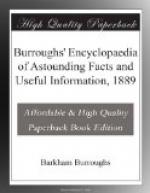3d. Multiply length by height, and then by width, add two ciphers to the result and divide by 124; this gives the number of bushels of ear corn.
HOME DRESSMAKING.
The art of dressmaking in America has been of late years so simplified that almost anyone with a reasonable degree of executive ability can manufacture a fashionable costume by using an approved pattern and following the directions printed upon it, selecting a new pattern for each distinct style; while in Europe many ladies adhere to the old plan of cutting one model and using it for everything, trusting to personal skill or luck to gain the desired formation. However, some useful hints are given which are well worth offering after the paper pattern has been chosen.
The best dressmakers here and abroad use silk for lining, but nothing is so durable or preserves the material as well as a firm slate twill. This is sold double width and should be laid out thus folded: place the pattern upon it with the upper part towards the cut end, the selvedge for the fronts. The side pieces for the back will most probably be got out of the width, while the top of the back will fit in the intersect of the front. A yard of good stuff may be often saved by laying the pattern out and well considering how one part cuts into another. Prick the outline on to the lining; these marks serve as a guide for the tacking.
In forming the front side plaits be careful and do not allow a fold or crease to be apparent on the bodice beyond where the stitching commences. To avoid this, before beginning stick a pin through what is to be the top of the plait. The head will be on the right side, and holding the point, one can begin pinning the seam without touching the upper part of the bodice. To ascertain the size of the buttonholes put a piece of card beneath the button to be used and cut it an eighth of an inch on either side beyond. Having turned down the piece in front on the buttonhole side run a thread a sixteenth of an inch from the extreme edge, and again another the width of the card. Begin to cut the first buttonhole at the bottom of the bodice; and continue at equal distances. The other side of the bodice is left wide enough to come well under the buttonholes. The buttonholes must be laid upon it and a pin put through the center of each to mark where the button is to be placed. In sewing on the buttons put the stiches in horizontally; if perpendicularly they are likely to pucker that side of the bodice so much that it will be quite drawn up, and the buttons will not match the buttonholes.




